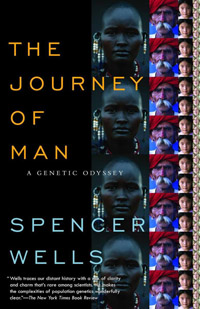
You are descended from a man who lived in Africa about 59,000 years ago. Do you find this hard to believe or accept? Well, that’s not all. Every other guy living on Planet Earth today is also descended from the same man! Man, wasn’t he a lucky man! The poor savage wouldn’t have imagined this level of success even in his wildest dreams!
How did the descendants of all the other ancients disappear into thin air? And if all of us have a common male ancestor then why do we all look so different? What accounts for our different colors and characteristics? Does race mean anything at all? How did the descendants of this super grandpa spread all over the planet? Where did they go first? How long did they remain in Africa?
This path-breaking book tries to answer all these questions. Earlier studies had revealed that all of us are descended from a single female ancestor (called Mitochondrial Eve) who lived about 150,000 years ago in Africa. Charles Darwin wrote in 1871, “It is therefore probable that Africa was formerly inhabited by extinct apes closely allied to the gorilla and chimpanzee, and as these two species are now man’s nearest allies, it seems somewhat more probable that our early progenitors lived on the African continent than elsewhere.” How right he was!
Today we know that apes lived in Africa some 23 million years ago. We went searching for the so-called ‘missing link’ and we found Homo Erectus, the first stand-up man. We wondered whether some of us are descended from the Neanderthals. We were puzzled about the Java Man, the Peking Man and so many others. It appears now that the Southern Ape is more likely to be our direct ancestor than any of these guys. The oldest genetic lineages are found in people living in eastern and southern Africa.
The sequencing of the human genome provided several answers and threw up just as many questions. Humans were in Australia 50,000-60,000 years ago. They are the only primates on the continent. This means they must have colonized the continent from elsewhere. The DNA trail leads to Africa. Homo erectus never made it to Australia, though they inhabited the island of Java. The aborigines of Australia have a lot in common with the Bushmen of southern Africa. How did homo sapiens travel to Australia so long ago? Did they make boats? Traces left by modern humans in Europe date back to a mere 40,000 years! And Europeans claim they ‘discovered’ Australia! Obviously 21st century humans need to unlearn much that they had learnt.
There is evidence to show that early moderns arrived in India from the south rather than the north. The Dravidian languages are completely unrelated to the Indo-European languages. And DNA markers seem to indicate that the Aryan invasion theory is not without substance.
As early as 1787, Thomas Jefferson wrote, “The resemblance between the Indians of America and the Eastern inhabitants of Asia would induce us to conjecture that the former are the descendants of the latter, or the latter of the former…” We know now that Jefferson had hit the nail on the head. It was across the Bering Strait that modern man came to the new World – and it took him only a thousand years to reach the southern tip of South America. Spencer Wells adds that, “Three-quarters of the large mammals in the Americas were driven to extinction around this time, among them mammoths and horses – the latter weren’t to reappear in the Americas until the Spaniards introduced them in the fifteenth century.”
Overall Assessment: A fascinating read. Biologists, anthropologists, geneticists, truth-seekers, DO READ!
The Journey of Man: A Genetic Odyssey
Author: Spencer Wells
Publisher: Random House
Date of Publication: 2003
Contributor: Pushpa Kurup lives in Trivandrum, India and works in the IT sector.